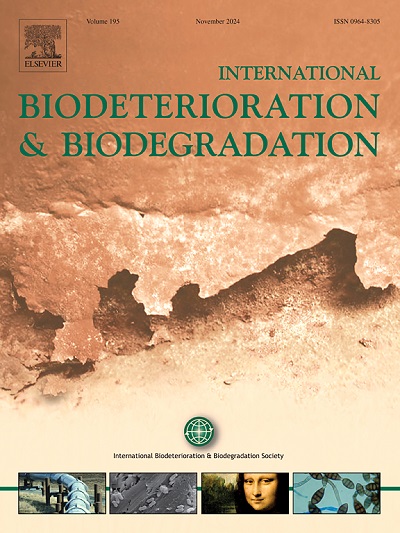附着基因的动态特性及其在好氧颗粒污泥发育中的作用
IF 4.1
2区 环境科学与生态学
Q2 BIOTECHNOLOGY & APPLIED MICROBIOLOGY
International Biodeterioration & Biodegradation
Pub Date : 2025-07-09
DOI:10.1016/j.ibiod.2025.106160
引用次数: 0
摘要
好氧颗粒污泥(AGS)是一种具有生物膜结构的微生物集合体。在遗传水平上理解微生物附着对于阐明AGS生物膜形成的潜在机制至关重要。本研究采用RT-qPCR技术评估关键附着基因(rmlA、rpfF和fliD)与肉芽的相关性。不同污泥结构的对比分析表明,成熟AGS中附着基因的丰度比絮凝污泥高1-2个数量级。这表明微生物聚集的程度与这些附着基因的丰度平行增加。此外,3个关键附着基因的存在及其动态特性与颗粒大小呈显著正相关(rmlA: r = 0.91, p <;0.001;rpfF: r = 0.88, p <;0.01, fliD: r = 0.97, p <;0.001)。在AGS培养过程中,对附着基因表达的动态定量分析显示了阶段特异性优势:rpfF通过群体感应促进了早期的聚集,而在AGS稳定过程中,fliD的数量急剧增加(从1.6 × 103增加到2.56 × 105拷贝·(g·SS) - 1),在成熟过程中超过了rmlA (1.47 × 104拷贝·(g·SS) - 1和rpfF (1.12 × 105拷贝·(g·SS) - 1)。用窄养单胞菌AGS-1进行生物强化,可使附着基因扩增量增加2-3个对数单位,同时竞争性地排除低丰度微生物群,选择性地富集功能优势菌群。高附着细菌可能通过附着基因的表达介导AGS的形成。本研究首次揭示了好氧肉芽形成机制是一种基因驱动的细菌聚集过程,突出了附着基因在AGS发育中的作用,为AGS技术中的生物膜调控提供了指导。本文章由计算机程序翻译,如有差异,请以英文原文为准。
Dynamic characteristics of attachment genes and their role in aerobic granular sludge development
Aerobic granular sludge (AGS) is a microbial aggregate with a biofilm structure. Understanding microbial attachment at the genetic level is crucial for elucidating the potential mechanisms underlying AGS biofilm formation. This study applied RT‒qPCR to assess the correlation between key attachment genes (rmlA, rpfF, and fliD) and granulation. Comparative analysis of different sludge structures revealed that the abundances of attachment genes were 1–2 orders of magnitude greater in mature AGS than in floccular sludge. This indicated that the degree of microbial aggregation increased in parallel with the abundance of these attachment genes. Furthermore, the presence and dynamic characteristics of three key attachment genes showed significant positive correlations with granulation, particularly granule size (rmlA: r = 0.91, p < 0.001; rpfF: r = 0.88, p < 0.01, fliD: r = 0.97, p < 0.001). Dynamic quantification of attachment gene expression during AGS cultivation revealed stage-specific dominance: rpfF facilitated early-stage aggregation via quorum sensing, whereas fliD exhibited a steep increase (from 1.6 × 103 to 2.56 × 105 copies·(g·SS)−1) during AGS stabilization, surpassing rmlA (1.47 × 104 copies·(g·SS)−1 and rpfF (1.12 × 105 copies·(g·SS)−1) during maturation. Bioaugmentation with Stenotrophomonas AGS-1 increased attachment gene amplification by 2–3 log units while competitively excluding low-abundance microbial groups and selectively enriching functionally dominant consortia. High-attachment bacteria may mediate AGS formation via attachment gene expression. This study revealed aerobic granulation mechanisms as a gene-driven bacterial aggregation process for the first time, highlighting the role of attachment genes in AGS development and providing guidance on biofilm regulation in AGS technology.
求助全文
通过发布文献求助,成功后即可免费获取论文全文。
去求助
来源期刊
CiteScore
9.60
自引率
10.40%
发文量
107
审稿时长
21 days
期刊介绍:
International Biodeterioration and Biodegradation publishes original research papers and reviews on the biological causes of deterioration or degradation.

 求助内容:
求助内容: 应助结果提醒方式:
应助结果提醒方式:


